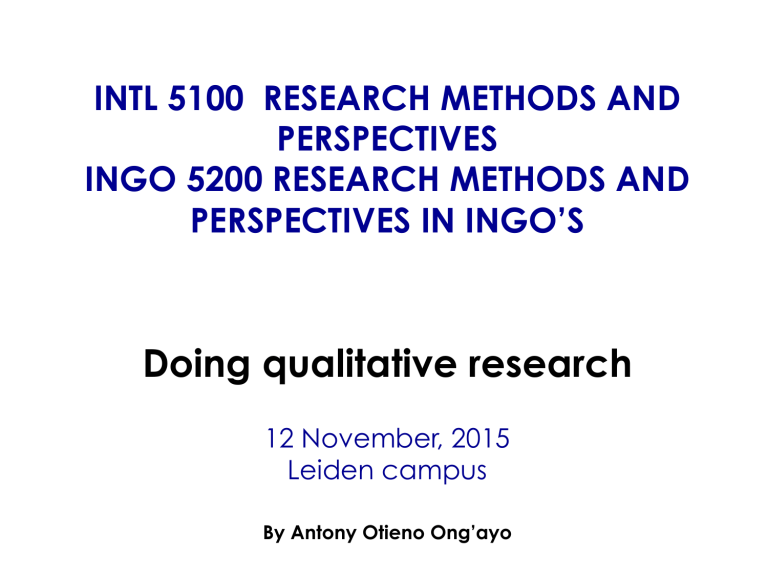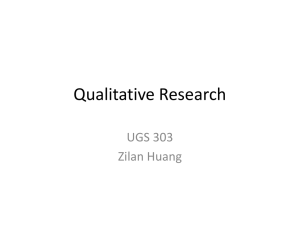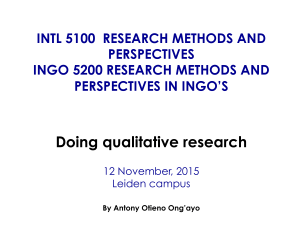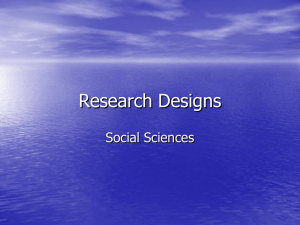
INTL 5100 RESEARCH METHODS AND PERSPECTIVES INGO 5200 RESEARCH METHODS AND PERSPECTIVES IN INGO’S Doing qualitative research 12 November, 2015 Leiden campus By Antony Otieno Ong’ayo Clarifications of concepts • • • • • • • • Paradigms Theories Mixed methods Selection (bias) Comparison Reliability Validity Variables Variables • Can take on a number of values • Examples: Individual characteristics, age, income, or education, religion • Categorical: Age • 18-24 years, 25-34 • Nominal: Religion • Catholic, protestant, evangelical, Muslim, Jew, Hindu • order-a scale: 'strongly agree' to 'strongly disagree • Different people have different values or scores on these characteristics Relationships between variables • Example: education and voter turnout • how is education related to voter turnout • independent variable = the "cause" and • dependent variable = the "effect." • Steps: • start with dependent variable then identify independent variables that are strongly related to the dependent variable Starting a thesis • What is your concept (theme) of your thesis? • What is your research question? • What is your dependent variable in this research question? • What is the definition of your dependent variable (specify how you would measure your dependent variable (s) • What are potential explanatory variables? • What is the relation between your dependent and explanatory variables? Split in TEAMS of 3 persons, use exercise sheet to start. Doing qualitative research • • • • • • • Design Formulating a Research Question Using Theories Choosing a Methodology Number Cases Ethics Research Proposal Types of research designs • • • • • • • • • • • Surveys Experiments Fieldwork Longitudinal Cross-sectional Case study Comparative Secondary analysis Action research Evaluation research Impact assessment Design Title The problem/introduction Aims/Goals/objectives Research questions Literature review Research strategy (inductive/deductive/abductive) Concepts/models/framework/theoretical framework • Methodology • • • • • • – – – – Data sources, types and forms Selection of data sources Data collection and timing Data reduction and analysis • Problems and limitations Formulating a Research Question • Defines the scope of the study • Determines what is to be studied • Types Examples – What questions: what are the characteristics of a dictator? – Why questions: why people think and act in a certain way? – How questions: how can corporate corruption be stopped? • Corresponding purposes – Description – Explanation/understanding – change Using Theories • Derives from different fields • Examples of theoretical perspectives – Realism, idealism, feminism (Herding), Marxism, interpretivism, • Other categories functionalism, structuration (Giddens); phenomenology (Berg, Luckman); structuralism (Foucault, Levi Strausse), critical theory (Habermas); conflict (Weber), RCT (Weber) Choosing a Methodology • Qualitative • Quantitative • Mixed methods - Triangulation • Strategy – Case study – Within case study – Comparison Case selection • Number of Cases (n/N) • Selection criteria – Similarities or differences between groups – Random process – Purposive – Snowball – Systematic- from fixed intervals • Selection bias – In the choices - of group/variables/subject – Baseline characteristics of the groups that are compared Research Proposal - Content Aims Significance Background - research problem Budget and justification Timeframe for each stage Expected outcome ad benefits Ethical issues and how to deal with them How the findings will be communicated/ disseminated • Bibliography • • • • • • • • Use of research proposals • • • • Public presentations and feedback Obtaining approval from authorities Applying for grants Preparation of a study/fieldwork Note: The purpose/use determines the design MAJOR STEPS • • • • • Formulating a Research Question Using Theories Choosing a Methodology How Many Cases Do You Need? Ethical Research • Writing a Research Proposal Main tools/techniques • • • • • • • • Interviews Ethnographies Content analysis/texts Audio data Visual data Participant observations Focus group discussions Surveys Interviewing in Qualitative Research • Structured /standardized: self-completion questionnaire- closed or close ended (Supervised, postal, internet) • Semi-structured: Open questions • Unstructured: list of topics • Ethnographic/intensive • In-depth: structured and semi structured • Focus group: discuss issue in specific group(s) • Life history • Oral historical Differences between structured and qualitative interviews • Qualitative interviews… – are less structured/standardized – take the participant’s viewpoint – encourage ‘rambling’ off the topic – are more flexible – seek rich, detailed answers – aim to understand rather than to generalize Types of qualitative interview • Unstructured interview – few, loosely defined topics – open-ended questions to allow free response – conversational style • Semi-structured interview – list of specific topics to cover (interview guide) – flexible question order and phrasing • Life history interview – subject looks back across their entire life – reveals how they interpret, understand and define the social world (Faraday & Plummer, 1979) – shows how life events have unfolded – naturalistic, researched or reflexive (Plummer, 2001) • Oral history interview – subject reflects on specific events in the past – testimonies of ‘unexceptional’ social groups Preparing an interview guide • memory prompts of topics to be covered • focus on research questions: ‘what do I need to know about?’ • logical but flexible order of topics • record ‘face sheet’ information (name, age, gender, position etc.) • quiet and private setting • good quality recording machine What makes a good interviewer? • Kvale (1996) – knowledgeable – structures the interview – clear – gentle – sensitive/empathic – open – steers the conversation – critical/challenging – remembers what has been said – interprets meaning • Bryman (2004) – balanced • talks neither too much nor too little – ethically sensitive • informed consent • confidentiality • privacy Kinds of questions • Kvale (1996) – – – – – – – – – introducing (“Tell me about…”) follow-up probing specifying (“What happened next?”) direct indirect (“What do most people think about…?”) structuring (“Let’s move on to…”) silence interpreting (“Do you mean that…?”) • vignettes – ground questions in a concrete and realistic situation Feminist approaches to interviewing • the in-depth, face-to-face interview has become the paradigmatic ‘feminist method’ (Kelly et al, 1994) • unstructured or semi-structured rather than structured interviews (Oakley, 1981): – indefensible for women to ‘use’ other women – non-hierarchical research relationship – rapport and reciprocity • possible tension between researcher’s interpretation and women’s own perspective Qualitative interviewing versus participant observation • Advantages of participant observation – seeing through others’ eyes – learning the native language – taken for granted ideas more likely to be revealed – access to deviant or hidden activities – sensitivity to context of action – flexibility in encountering the unexpected – naturalistic emphasis Qualitative interviewing versus participant observation • Advantages of qualitative interviewing – – – – – – – – finding out about issues resistant to observation interviewees reflect on past events / life course more ethically defensible fewer reactive effects less intrusive longitudinal research (follow-up interviews) greater breadth of coverage specific focus




